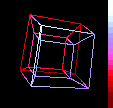3. The Speed of Light is Constant
Statement:
“The speed of light \(c\) is a universal constant,
the same in any inertial frame”.
 This postulate is the nub of special relativity,
and much of the content of these pages is concerned with
exploring its paradoxical consequences,
starting with the next page,
The Paradox of Special Relativity.
Amongst other strange consequences,
the postulate implies that the time dimension behaves in many ways
as if it were an imaginary spatial dimension.
Watch this
4D spacetime hypercube rotate (47K GIF movie).
Measuring speed requires being able to measure intervals of both
space and time: speed is distance travelled divided by time elapsed.
Inertial frames constitute a special class of spacetime coordinate systems;
it is with respect to distance and time intervals
in these special frames that the speed of light is asserted to be constant.
In general relativity, arbitrarily weird coordinate systems are allowed,
and light need move neither in straight lines nor at constant velocity
with respect to bizarre coordinates
(why should it, if the labelling of space and time is totally arbitrary?).
However, general relativity asserts the existence of locally inertial frames,
and the speed of light is a universal constant in those frames.
In 1983, the General Conference on Weights and Measures
officially defined the
speed of light
to be
\[
c = \mbox{299,792,458 meters/second ,}
\]
and the meter, instead of being a primary measure,
became a secondary quantity,
defined in terms of the second and the speed of light.
This postulate is the nub of special relativity,
and much of the content of these pages is concerned with
exploring its paradoxical consequences,
starting with the next page,
The Paradox of Special Relativity.
Amongst other strange consequences,
the postulate implies that the time dimension behaves in many ways
as if it were an imaginary spatial dimension.
Watch this
4D spacetime hypercube rotate (47K GIF movie).
Measuring speed requires being able to measure intervals of both
space and time: speed is distance travelled divided by time elapsed.
Inertial frames constitute a special class of spacetime coordinate systems;
it is with respect to distance and time intervals
in these special frames that the speed of light is asserted to be constant.
In general relativity, arbitrarily weird coordinate systems are allowed,
and light need move neither in straight lines nor at constant velocity
with respect to bizarre coordinates
(why should it, if the labelling of space and time is totally arbitrary?).
However, general relativity asserts the existence of locally inertial frames,
and the speed of light is a universal constant in those frames.
In 1983, the General Conference on Weights and Measures
officially defined the
speed of light
to be
\[
c = \mbox{299,792,458 meters/second ,}
\]
and the meter, instead of being a primary measure,
became a secondary quantity,
defined in terms of the second and the speed of light.
|
 Watch this
4D hypercube rotate (46K GIF movie).
The postulate that spacetime forms a 4-dimensional continuum
is a generalization of the classical Galilean concept
that space and time form separate 3 and 1 dimensional continua.
The postulate of a 4-dimensional spacetime continuum
is retained in general relativity.
Physicists widely believe that this postulate must ultimately break down,
that space and time are quantized over extremely small intervals
of space and time,
the Planck length
\(\sqrt{G \hbar / c^3} \approx 10^{-35}\) meters,
and the Planck time
\(\sqrt{G \hbar / c^5} \approx 10^{-43}\) seconds,
where \(G\) is
Newton's gravitational constant,
\(\hbar \equiv h / ( 2\pi )\)
is
Planck's constant divided by 2 pi,
and \(c\) is the
speed of light.
Watch this
4D hypercube rotate (46K GIF movie).
The postulate that spacetime forms a 4-dimensional continuum
is a generalization of the classical Galilean concept
that space and time form separate 3 and 1 dimensional continua.
The postulate of a 4-dimensional spacetime continuum
is retained in general relativity.
Physicists widely believe that this postulate must ultimately break down,
that space and time are quantized over extremely small intervals
of space and time,
the Planck length
\(\sqrt{G \hbar / c^3} \approx 10^{-35}\) meters,
and the Planck time
\(\sqrt{G \hbar / c^5} \approx 10^{-43}\) seconds,
where \(G\) is
Newton's gravitational constant,
\(\hbar \equiv h / ( 2\pi )\)
is
Planck's constant divided by 2 pi,
and \(c\) is the
speed of light.
